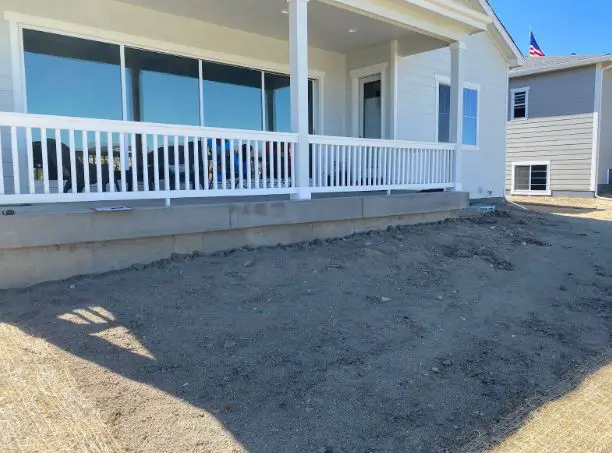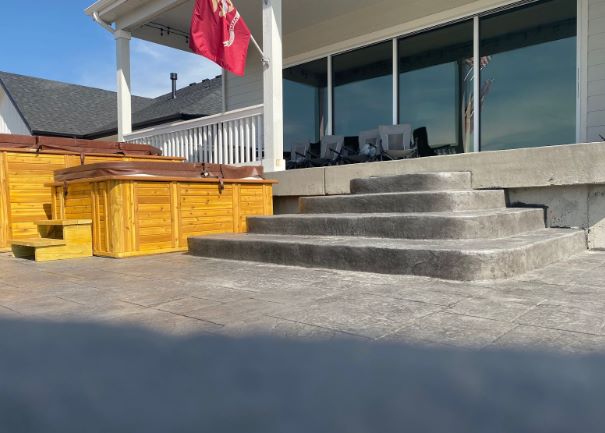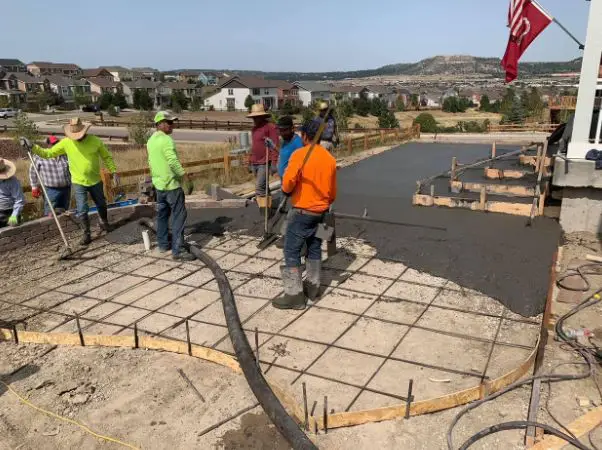how much does a concrete patio cost in 2025
Updated: March 17, 2025
Author: Mike Day
Are you wondering about the cost of building a concrete patio?
For a 300-square-foot concrete patio with no stairs, no thickened edge, easy access, and a gray broom finish, we typically charge $3,900.
It's a common question, and the answer depends on several variables. In this blog, we'll discuss some of the factors that contribute to the price of a concrete patio, including:
- Grading requirements
- The need for stairs
- Thickened edges
- Size of the patio
- Site accessibility
- Any decorative features such as stamped or colored concrete
It's also important to note that while a certain amount of road base is standard for patio construction, additional roadbase beyond the norm will incur extra costs.
the cost of grading for a concrete patio
When preparing a bid for a client's concrete patio project, one of the first questions to consider is whether the site requires an unusual amount of grading.

While some grading is expected for all concrete projects, exceeding four hours of grading work results in an additional charge of $150 per hour.
The reason for prioritizing grading is to minimize the need for a thickened edge on the patio, which is both more expensive and less visually appealing.
By grading the patio area appropriately, we can use the least amount of concrete necessary (usually 4" thick) to install a strong patio slab.
In the image above, you can see an example of a project that required some grading, which we were able to complete within four hours, resulting in no additional charge to the client.
adding stairs to a concrete patio: cost considerations

When estimating the cost of a concrete patio, it's essential to consider whether the patio will include stairs.
Forming stairs can be time-consuming and require additional materials, such as lumber, that will ultimately be disposed of.
Additionally, stairs require extra gravel prep work and more concrete to pour, resulting in more surface area for the finishers to complete.
If the patio is stamped, the process is even more challenging, as stamping stairs requires more precision and skill.
To account for these factors, we charge an additional $50 per linear foot of stairs.
For example, a three-foot-wide sidewalk with stairs would cost an extra $150 per step.
The picture above illustrates how stairs can quickly increase the cost of a concrete patio, particularly if there are multiple steps.
While stairs are often necessary, it's worth considering alternatives or modifications to keep costs down.
For instance, a shallower or wider set of stairs may be less expensive than a steeper, narrower set, or you may choose to forgo stairs altogether if the patio is on a flat surface.
how much extra for thickened edges?

Another factor that can increase the cost of a concrete patio is the need for a thickened edge.
While grading can help to minimize the need for a thickened edge, it's not always enough.
Especially if the yard slopes from one side of the house to the other instead of from the house toward the property line.
A thickened edge refers to a section of the concrete patio with a face taller than four inches, and it comes with additional costs.
To form a thickened edge, we use larger lumber than the standard two-by-fours, which increases material costs.
Additionally, the edge of the patio area where the thickened edge is required will be dug out and filled with concrete, adding more concrete costs.
Thickened edges are priced similarly to stairs:
A four-inch thickened edge is included in the standard cost of a concrete patio, but once it reaches seven inches, additional costs will incur.
We charge $50 per linear foot for thickened edges up to seven inches tall and $100 per linear foot for edges up to fourteen inches.
If the thickened edge is larger than fourteen inches, we adjust the price on a case-by-case basis, depending on the amount of lumber, time, and extra concrete required.
how patio size affects the cost
The size of a concrete patio is one of the most obvious factors that affects the cost.
While there are basic costs associated with every concrete pour that cannot be reduced, such as the cost of the concrete pump, these costs can be spread over a larger area with a larger patio, resulting in a lower per-square-foot cost.
The minimum pour that can be installed without incurring short haul fees is 300 square feet, which is roughly the size of a typical sidewalk going from the front to the rear of a home.
For a 300 square foot patio with no stairs, no thickened edge, easy access, and a gray broom finish, the total cost is $3,500.
This price covers the cost of our forms, road base, rebar, concrete, and a $100 markup on the $650 concrete pump rental, with enough profit to make the job worthwhile.
For larger patios, the price per square foot is typically lower.
Assuming that the patio is over 300 square feet, has no stairs, no thickened edge, easy access, and a gray broom finish, the typical cost is around $11 per square foot plus the $750 rental fee for the concrete pump.
As the patio size increases, additional factors, such as the need for stairs, a thickened edge, or decorative finishes, will add to the cost.
The location of your patio may affect the total cost
The accessibility of a site is another critical factor that affects the cost of a concrete patio.
For instance, patios installed on newly constructed homes with open access and no existing landscaping are often easier and more affordable to install.
In contrast, for patios being installed in the backyard of homes with tight access and existing landscaping, it's necessary to assess the most cost-effective way to complete the job.
As a contractor, I need to determine whether it's cheaper to replace some of the landscaping or use manual labor with a wheelbarrow, shovel, and pick instead of a skid steer.
When assessing costs, I have to consider the labor charges for skilled labor, which we typically charge at $85 per hour, or general labor, which we charge at $65 per hour.
Additionally, the cost of disposing of any landscaping that needs to be removed must also be factored into the price.
We typically charge an extra $500 for up to 5 yards or 5 tons of existing landscape or debris removal, covering the cost of landfill disposal, the driver, truck wear and tear, and fuel.
In an ideal world, all concrete patios would be installed on newly constructed homes with easy access and no existing landscaping to remove.
However, this isn't always the case, and assessing the accessibility of a site is critical to determining an accurate patio cost estimate.
how stamping and colored concrete affect the cost
Stamping and coloring are two critical factors that can significantly increase the cost of a concrete patio.
To color our concrete, we mix an integral pigment color with the concrete on the truck, which is more expensive than a skim coat.
However, it enables the patio to maintain its color for its entire life.
Stamping concrete is a time-consuming process that requires specialized finishers who are only on-site during the pouring day.
The stamps are applied with a release agent, either in spray or powder form, and pressed down with a tamper while the concrete is still uncured. It's a race against time as the concrete is curing, and the stamping process must be completed before it gets too far in the curing process, or the stamp will be uneven across the patio.
After a day of curing, we saw cut the joints to control where any cracking would happen.
For stamped patios, we apply an antique wash to create a two-tone effect, followed by a couple of coats of sealer.
The process of stamping and coloring the concrete adds to the labor and material costs, significantly affecting the client's cost.
We charge an additional $2 per square foot for coloring the concrete and another $7 per square foot for stamping, bringing the total cost of a colored concrete patio to $13 per square foot and a stamped concrete patio to $21 per square foot.
However, this price does not include the cost of the concrete pump rental and assumes that there are no stairs or thickened edges.
how rebar and road base affect the cost of a concrete patio

The presence of rebar and road base can also affect the cost of a concrete patio. Rebar is installed in all our patios to add to their integrity by preventing cracking.
Additionally, road base is installed and compacted in all our patios, but the amount required can vary. While no additional fees were necessary for the job in the above picture, on other projects, we may need extra road base gravel.
Extra road-base is usually needed when there is an unusually low spot in one area or when the slope of the yard goes from one side of the patio to the other, and the homeowner does not want a step down.
We charge $150 per ton for any extra road base needed, covering the purchase price, delivery, installation, and compaction. While a patio rarely requires more than ten additional tons of road base, it's possible in some cases.
The presence of rebar and road base is essential for a stable and durable concrete patio, which is why we always install both.
While the cost of additional road base can vary, it's important to consider this when estimating the overall cost of the project.
in conclusion: the finished concrete pato

Estimating the cost of a concrete patio is a complex process that involves multiple factors.
These include site accessibility, grading, stairs, thickened edges, coloring, stamping, rebar, and road base.
While each of these factors adds to the cost of the project, they also ensure that the finished product is stable, durable, and aesthetically pleasing.
A well-designed and well-built concrete patio can significantly increase the value of a property, while providing a comfortable and functional outdoor living space for a very long time.
At the end of the day, the cost of a concrete patio depends on the specific needs of the client, the size and complexity of the project, and the quality of the materials used.
With the right planning and execution, a concrete patio can be a beautiful addition to any home, providing years of enjoyment for the family and adding value to the property.
Article provided by www.customlandscapesbydesign.com














